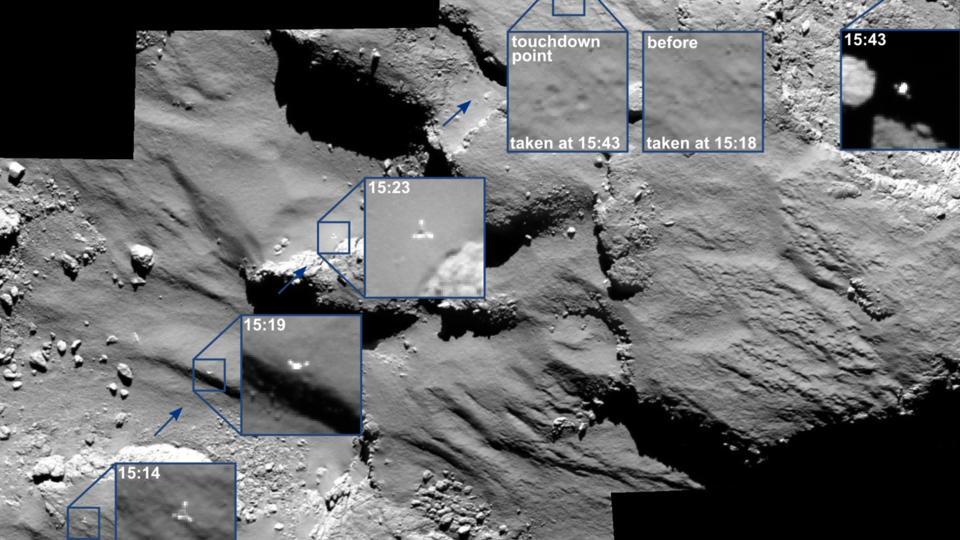Science News
A Bounce, a Burn, and a Boot
Philae Phollowup
After the harpoons meant to anchor it to the surface of Comet 67P/Churyumov-Gerasimenko (or 67P) failed to fire, ESA’s Philae lander took a kilometer-high bounce and didn’t come back down for two hours. Then, it took a second, shorter bounce, finally coming to rest awkwardly in the shadow of a cliff that prevented sunlight from sufficiently recharging its solar-powered batteries. But in the short, 60 hours of power that it had after touchdown, the plucky probe put its ten instruments to work, detecting water and carbon-based molecules, measuring the comet’s magnetic field, analyzing of the comet’s interior structure using radio waves, sensing the temperature at its three points of contact with the comet, determining the thickness of the dust layer covering the comet’s icy surface (at least where it landed), and confirming from a drilling attempt that the surface is harder than expected.
Despite the difficulties associated with its bumpy landing, Philae was still able to accomplish some valuable measurements, and its mother ship, Rosetta, is still orbiting 67P, Rosetta will continue to monitor the comet through the mission’s nominal conclusion at the end of 2015, enjoying a front-row view of the transformation that occurs on and within a comet as it rounds the Sun next August. Even as that happens, scientists are hopeful that the change in illumination will be enough to recharge Philae’s batteries, giving it a second life, allowing Philae to reawaken and rise again (figuratively speaking) like a Phoenix.
-Bing Quock
Jupiter’s Sunburn
Jupiter is a planet of striking features—it is the largest and most massive planet in our solar system, with the highest moon count (67) and dynamic, wind-blown stripes across its upper layers of atmosphere. One of its best known features is the Great Red Spot, a storm similar to a hurricane, but twice the diameter of Earth, that has been raging on the planet for at least 350 years. But where does that distinctive red color come from?
One theory is that the color originates in chemicals from underneath the storm’s clouds, meaning the cloud layers should be red throughout. However, laboratory experiments done by scientists from NASA’s Jet Propulsion Laboratory (JPL) in which ammonia and acetylene gases (chemicals known to exist on Jupiter) were blasted with ultraviolet light, to (simulate the Sun’s light) show something different.
“Our models suggest most of the Great Red Spot is actually pretty bland in color, beneath the upper cloud layer of reddish material,” says Kevin Baines of JPL. "Under the reddish ‘sunburn’ the clouds are probably whitish or grayish.”
Their findings are a good fit with data from the Cassini mission’s flyby in 2000 on its way to Saturn. So instead of the red starting deeper inside and rising to the upper layers like someone blushing, the color may actually be more like a sunburn, coming from atmospheric chemicals breaking down under Sun’s destructive UV light—an even better analogy since the Sun’s UV light is what causes skin damage.
-Elise Ricard
Ejected Black Hole or Dying Rare Star?
Astronomers have been watching SDSS1133 for 63 years and this week they’ve finally described what the bright object may be—twice. Located 90 million light years away from Earth, in the cup of the Big Dipper within the constellation Ursa Major, the team of scientists believe that the object is either an ejected black hole or the remnants of an unusual type of star. (Kind of choose your own adventure-style. If you pick black hole, read on; if you pick star, skip to the third paragraph.)
“We suspect we're seeing the aftermath of a merger of two small galaxies and their central black holes,” says Laura Blecha, of the University of Maryland and co-author on a study published this week in Monthly Notices of the Royal Astronomical Society. Blecha and her colleagues believe that SDSS1133 resided in a galaxy that merged with the dwarf galaxy Markarian 177. In this type of merger, if both galaxies’ black holes have equal masses and spins, their merger emits gravitational waves uniformly in all directions. But, more likely, the black hole masses and spins will be different, leading to lopsided gravitational wave emission that launches the black hole in the opposite direction. And that may be the case with SDSS1133—a booted black hole that will continue to shine until all of the gas is consumed. (ScienceShot has a video of the potential merger.)
And if it isn’t an orphan black hole, the scientists speculate that SDSS1133 might have been a very unusual type of star known as a Luminous Blue Variable (LBV). These massive stars undergo episodic eruptions that cast large amounts of mass into space long before they explode. Interpreted in this way, SDSS1133 would represent the longest period of LBV eruptions ever observed, followed by a terminal supernova explosion whose light reached Earth in 2001.
To analyze the object in greater detail, the team is planning ultraviolet observations with the Cosmic Origins Spectrograph aboard the Hubble Space Telescope in October 2015. Whether it's a rogue supermassive black hole or the closing act of a rare star, it seems astronomers have never seen the likes of SDSS1133 before.
-Molly Michelson
Images: Philae landing, ESA/Rosetta/MPS for OSIRIS Team MPS/UPD/LAM/IAA/SSO/INTA/UPM/DASP/IDA; Jupiter's Great Red Spot, NASA / JPL / Space Science Institute; Markarian 177 and SDSS1133 (lower left), W. M. Keck Observatory/M. Koss (ETH Zurich) et al.


